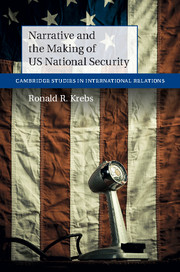Book contents
- Frontmatter
- Dedication
- Contents
- List of figures
- List of tables
- Acknowledgments
- 1 Narrating national security
- PART I Crisis, authority, and rhetorical mode: the fate of narrative projects, from the battle against isolationism to the War on Terror
- 2 Domination and the art of storytelling
- 3 Narrative lost: missed and mistaken opportunities
- 4 Narrative won: opportunities seized
- PART II Narrative at war: politics and rhetorical strategy in the military crucible, from Korea to Iraq
- Conclusion
- Appendices
- References
- Index
- Cambridge Studies in International Relations
3 - Narrative lost: missed and mistaken opportunities
from PART I - Crisis, authority, and rhetorical mode: the fate of narrative projects, from the battle against isolationism to the War on Terror
Published online by Cambridge University Press: 05 December 2015
- Frontmatter
- Dedication
- Contents
- List of figures
- List of tables
- Acknowledgments
- 1 Narrating national security
- PART I Crisis, authority, and rhetorical mode: the fate of narrative projects, from the battle against isolationism to the War on Terror
- 2 Domination and the art of storytelling
- 3 Narrative lost: missed and mistaken opportunities
- 4 Narrative won: opportunities seized
- PART II Narrative at war: politics and rhetorical strategy in the military crucible, from Korea to Iraq
- Conclusion
- Appendices
- References
- Index
- Cambridge Studies in International Relations
Summary
President Franklin Delano Roosevelt was, by all accounts, a master orator. His Fireside Chats are cited as paradigmatic moments of presidential rhetorical leadership. Nearly half a century later, Ronald Reagan entered the Oval Office, known as the “Great Communicator” for his capacity to connect with and inspire mass audiences. If any presidents should have been able to impose their will on the nation's security narratives, they should have. Yet, Roosevelt could not shunt aside the non-interventionist alternative before Pearl Harbor, and Reagan could not persuade Americans of the danger that Nicaragua's governing Sandinistas posed to US national security, nor could he silence his, and the Nicaraguan rebels', critics. Rhetorical skill is not, on its own, enough to ensure narrative dominance – as these masters of the bully pulpit would attest.
Perhaps Roosevelt and Reagan failed because “going public” is simply not effective. That inference would be warranted if presidents' interventions did not sometimes profoundly shape the contours of US political debate – but they do. One might argue that presidents fall short when they are not skilled orators, when they are not deeply committed to the cause, and when they are reluctant to expend resources and to risk political capital – but the examples of Roosevelt and Reagan suggest otherwise. The theoretical framework of the preceding chapter offers four possible explanations. First, presidents can misread the narrative situation. They may wrongly believe that they are facing an unsettled period in which public demand for storytelling is high, and so they may traffic heavily in that rhetorical mode. In short, a mistaken opportunity. Second, presidents can err in thinking the political structure highly constrained, shy away from storytelling even when it might be well received, and opt for argument to legitimate their policies. In short, a missed opportunity. Third, presidents can remain silent and fail to seize the rhetorical initiative, allowing others to fill the narrative vacuum – another missed opportunity. Both missed and mistaken opportunities permit narrative alternatives to flourish and channel opposition to leaders' programs. Fourth, presidents can be dealt a bad rhetorical hand – the absence of opportunity. When public demand for storytelling is low, whether because the narrative situation is settled or because they are operating in the wake of foreign policy triumph, presidents can do little to rewrite the nation's security narrative.
- Type
- Chapter
- Information
- Narrative and the Making of US National Security , pp. 66 - 121Publisher: Cambridge University PressPrint publication year: 2015

